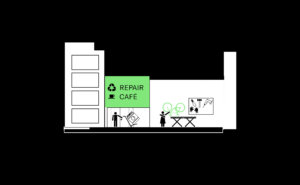
C.3 Balance Between Public & Private Land
Public ownership of manufacturing space enables public interests to have an active stake in neighbourhood issues while ensuring space is available for unconventional or foundational forms of manufacturing.
[Context] While businesses generally prefer to own their land, purchasing space may be either inconvenient (expensive for cash-poor businesses) or impossible (because there is no suitable space available on the market). Cities with high real estate pressure can help guarantee that city-oriented makers (such as food, construction, resource management and so forth) can retain a place in the city, through public ownership of land, helping also to influence rental conditions and the nature of the organisation that have access to land (such as a cooperative or non-profit). Public land ownership also guarantees a stake in the area at the on equal terms as private owners. This means that public authorities have a more realistic understanding of issues faced by private landholders. Finally, in co-location projects or on sites where developers argue for land use change due to perceived lack of demand by the industrial sector, publicly owned land puts public actors in a strong position to understand the real needs of the local market and manufacturers.
[Problems] Very few public authorities have assets in manufacturing neighbourhoods beyond those for their own basic needs, such as for waste management, storage or equipment repair. As industrial land is generally a much lower priority than other forms of public infrastructure, such as hospitals or community centres, acquisition is a serious question. Furthermore, public authorities generally do not have experience as real estate managers, particularly for industrial land, therefore it may require acquiring new skills or staff. Finally, land itself may be useless without providing buildings or infrastructure to house manufacturers and therefore may require more significant public investment and long-term responsibility. Diving into such a commitment may be far too much for a public authority.
[Forces] Without owning land and curating the program (see R.3 Curator), public authorities will be limited in their capacity to balance or adapt the market, relying R.10 Place-based Financial Levers or market trends which may not result in the same objectives as those aspired to by the public sector. While on paper public authorities can define regulation and stipulate planning conditions for R.9 Assured Security of Space, in practice history has shown that private interests are capable of bending and adapting planning regulations into outcomes that are ultimately not in the public interest. Furthermore, creating space for facilities that support manufacturing, such as an P.8 Community Hub in Making Locations or P.7 Spaces for Development and Education, cannot be entrusted to the market if they’re to be genuinely inclusive.
[Solutions] Ensure public actors acquire assets to support a more diverse and just economic agenda, to protect or boost manufacturing and to correct conditions due to market failures. There are three aspects to the balance of public and privately owned land, namely: acquisition, development and management. Firstly acquiring and developing land can be difficult for cash-poor public authorities. However industrial land has been seen as a major investment opportunity by the private sector and can offer more attractive returns than housing in the long-term. Cities that can afford to purchase land, can help contribute to C.4 Diverse Tenure Models by filling any gaps in the market. Public authorities can strategically acquire industrial spaces in the process of adapting land for C.1 Microzoning – this can be a win-win if the private developer profits from the residential surface area at the cost of the construction of industrial space. Public authorities can also acquire land through larger infrastructure development (such as a highway) however this is far rarer and more expensive. Conversely, public authorities can purchase strategically important sites (like a market or waste management centre) and then sell the access to the site through time-share or lease the site management to a third party. Finally, the R.3 Curator can take on the role of asset manager and define rental/usage conditions. Where possible communicate plans and priorities by R.1 Making Making Visible.
[Contribution] Add contributions here.







